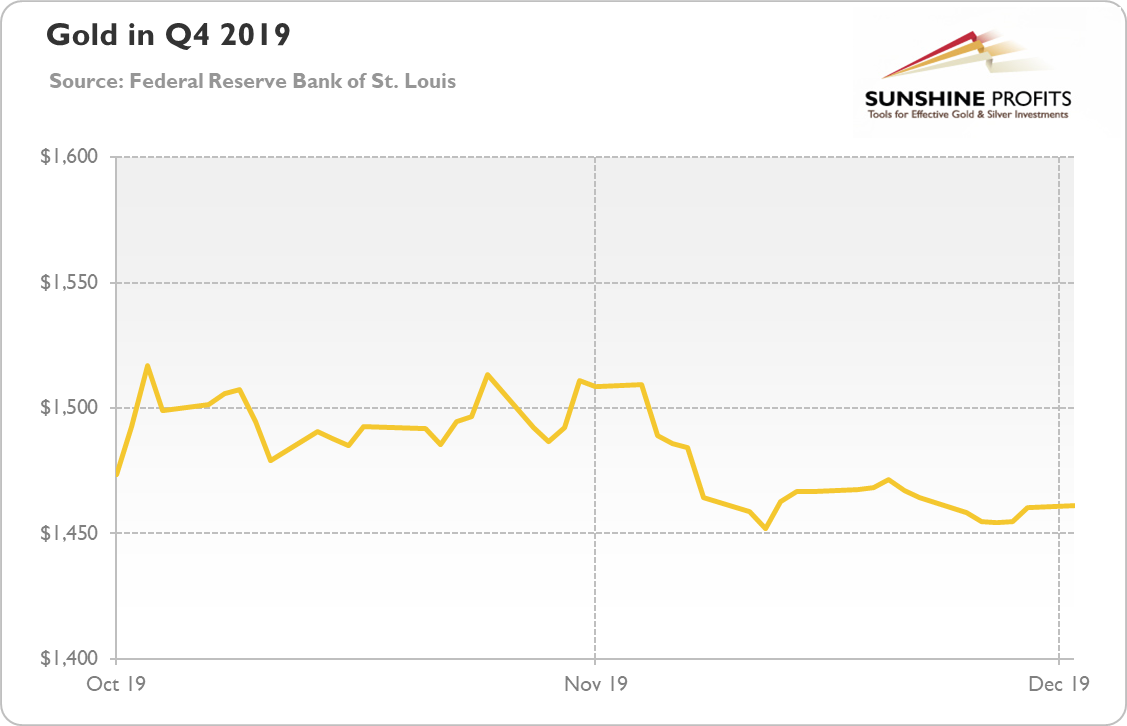Manufacturing Goes Deeper Into Recession, Yet Gold Price Remains Muted. Why?
The ISM Manufacturing Index fell 0.2 point to a reading of 48.1 in November. However, gold struggles to find momentum. What is going on exactly?
U.S. Manufacturing Sector Slumps Further
The Institute for Supply Management announced that its index of national factory activity dropped from 48.3 in October to 48.1 last month. The number was below expectations and it also remained below the 50 threshold, indicating contraction – shrinking for the fourth straight month. In other words, the manufacturing sector is still in recession.
We all know that. But what about the future and the broad economy? Well, situation looks better here, as the ISM index remains above the 42.9 level, which is associated with a recession in the broader economy. And the recent improvement in China’s PMIs prompt some to say that the ISM is bouncing along the bottom. Moreover, the strike at General Motors is over, while Boeing hopes to resume deliveries of its 737 MAX.
However, the decline in new orders – the New Orders Index registered 47.2 percent in November, a decrease of 1.9 percentage points from the October reading of 49.1 percent – suggests downside risk, if anything. The fact that Trump restored tariffs on steel and aluminum imports from Brazil and Argentina will not help the domestic manufacturing sector which already is struggling with higher tariffs, trade uncertainty, slowing profit growth and weak overseas demand.
Following shaky economic reports – besides data on manufacturing, the index of pending home sales dropped 1.7 percent, while the personal incomes were flat in October – the Federal Reserve Bank of Atlanta slashed its fourth-quarter GDP estimate from 1.7 to 1.3 percent annualized rate, reviving worries of a slowing domestic economy.
Implications for Gold
What does it all mean for the gold market? From the fundamental point of view, weaker industrial production should support gold prices. This is because the manufacturing sector’ problems could not only translate into slower economic growth, but also force the Fed to adopt again a more dovish stance and cut interest rates further in 2020.
But the manufacturing recession failed to spur rally in gold price in the fourth quarter of 2019 ( https://www.gold-eagle.com/rate/price-of-gold/ ), as the chart below shows. The gold prices are clearly struggling to find momentum, even in the face of disturbing data on the U.S. manufacturing sector.
Chart 1: Gold prices (London P.M. Fix, in $) from October to December 2019.
However, other economic data ended up better than expected. Investors also became more optimistic about the trade deal between China and the U.S. So, given where the general stock markets are, gold is actually not doing bad – but the key test will be yellow metal’s behavior in response to the recent greenback’s weakening. Stay tuned!
If you enjoyed today’s free gold report, we invite you to check out our premium services. We provide much more detailed fundamental analyses of the gold market in our monthly Gold Market Overview reports and we provide daily Gold & Silver Trading Alerts with clear buy and sell signals. In order to enjoy our gold analyses in their full scope, we invite you to subscribe today. You can still subscribe to our Alerts at very promotional terms – it takes just $9 to read the details right away and then receive follow-ups for the next three weeks. If you’re not ready to subscribe yet though and are not on our gold mailing list yet, we urge you to sign up. It’s free and if you don’t like it, you can easily unsubscribe. Sign up today!
Arkadiusz Sieron, PhD
Sunshine Profits – Effective Investments hrough Diligence and Care
Disclaimer: Please note that the aim of the above analysis is to discuss the likely long-term impact of the featured phenomenon on the price of gold and this analysis does not indicate (nor does it aim to do so) whether gold is likely to move higher or lower in the short- or medium term. In order to determine the latter, many additional factors need to be considered (i.e. sentiment, chart patterns, cycles, indicators, ratios, self-similar patterns and more) and we are taking them into account (and discussing the short- and medium-term outlook) in our trading alerts.
*********


















